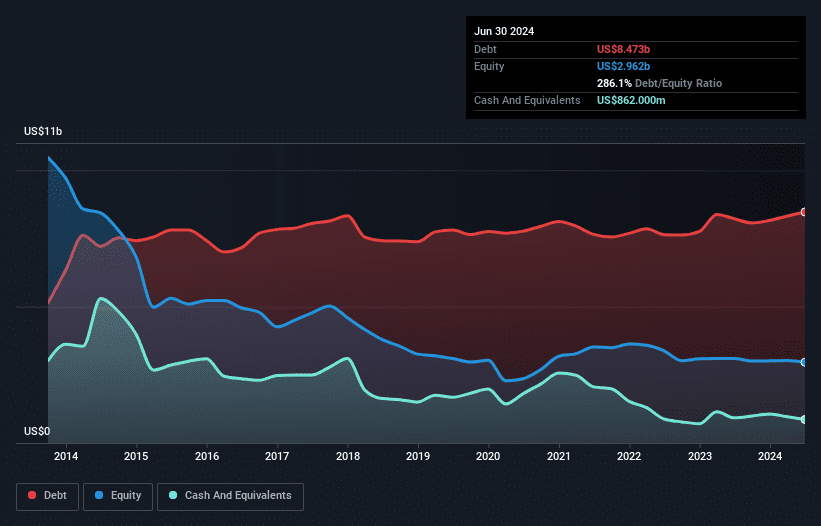David Iben put it well when he said, ‘Volatility is not a risk we care about. What we care about is avoiding the permanent loss of capital.’ It’s only natural to consider a company’s balance sheet when you examine how risky it is, since debt is often involved when a business collapses. As with many other companies Illinois Tool Works Inc. (NYSE:ITW) makes use of debt. But the real question is whether this debt is making the company risky.
What Risk Does Debt Bring?
Generally speaking, debt only becomes a real problem when a company can’t easily pay it off, either by raising capital or with its own cash flow. Ultimately, if the company can’t fulfill its legal obligations to repay debt, shareholders could walk away with nothing. However, a more frequent (but still costly) occurrence is where a company must issue shares at bargain-basement prices, permanently diluting shareholders, just to shore up its balance sheet. Having said that, the most common situation is where a company manages its debt reasonably well – and to its own advantage. The first step when considering a company’s debt levels is to consider its cash and debt together.
See our latest analysis for Illinois Tool Works
What Is Illinois Tool Works’s Debt?
The chart below, which you can click on for greater detail, shows that Illinois Tool Works had US$8.47b in debt in June 2024; about the same as the year before. However, it also had US$862.0m in cash, and so its net debt is US$7.61b.


debt-equity-history-analysis
How Strong Is Illinois Tool Works’ Balance Sheet?
Zooming in on the latest balance sheet data, we can see that Illinois Tool Works had liabilities of US$4.80b due within 12 months and liabilities of US$7.81b due beyond that. Offsetting this, it had US$862.0m in cash and US$3.25b in receivables that were due within 12 months. So its liabilities outweigh the sum of its cash and (near-term) receivables by US$8.50b.
Of course, Illinois Tool Works has a titanic market capitalization of US$75.5b, so these liabilities are probably manageable. However, we do think it is worth keeping an eye on its balance sheet strength, as it may change over time.
We use two main ratios to inform us about debt levels relative to earnings. The first is net debt divided by earnings before interest, tax, depreciation, and amortization (EBITDA), while the second is how many times its earnings before interest and tax (EBIT) covers its interest expense (or its interest cover, for short). Thus we consider debt relative to earnings both with and without depreciation and amortization expenses.
Illinois Tool Works’s net debt to EBITDA ratio of about 1.6 suggests only moderate use of debt. And its commanding EBIT of 18.4 times its interest expense, implies the debt load is as light as a peacock feather. The good news is that Illinois Tool Works has increased its EBIT by 7.1% over twelve months, which should ease any concerns about debt repayment. There’s no doubt that we learn most about debt from the balance sheet. But ultimately the future profitability of the business will decide if Illinois Tool Works can strengthen its balance sheet over time. So if you want to see what the professionals think, you might find this free report on analyst profit forecasts to be interesting.
Finally, a business needs free cash flow to pay off debt; accounting profits just don’t cut it. So we always check how much of that EBIT is translated into free cash flow. Over the most recent three years, Illinois Tool Works recorded free cash flow worth 62% of its EBIT, which is around normal, given free cash flow excludes interest and tax. This cold hard cash means it can reduce its debt when it wants to.
Our View
Illinois Tool Works’s interest cover suggests it can handle its debt as easily as Cristiano Ronaldo could score a goal against an under 14’s goalkeeper. And we also thought its conversion of EBIT to free cash flow was a positive. Taking all this data into account, it seems to us that Illinois Tool Works takes a pretty sensible approach to debt. While that brings some risk, it can also enhance returns for shareholders. When analysing debt levels, the balance sheet is the obvious place to start. But ultimately, every company can contain risks that exist outside of the balance sheet. These risks can be hard to spot. Every company has them, and we’ve spotted 1 warning sign for Illinois Tool Works you should know about.
If you’re interested in investing in businesses that can grow profits without the burden of debt, then check out this free list of growing businesses that have net cash on the balance sheet.
Have feedback on this article? Concerned about the content? Get in touch with us directly. Alternatively, email editorial-team (at) simplywallst.com.
This article by Simply Wall St is general in nature. We provide commentary based on historical data and analyst forecasts only using an unbiased methodology and our articles are not intended to be financial advice. It does not constitute a recommendation to buy or sell any stock, and does not take account of your objectives, or your financial situation. We aim to bring you long-term focused analysis driven by fundamental data. Note that our analysis may not factor in the latest price-sensitive company announcements or qualitative material. Simply Wall St has no position in any stocks mentioned.
Source link : http://www.bing.com/news/apiclick.aspx?ref=FexRss&aid=&tid=66f2c29efee74ebb9e31bdcce75f2cd1&url=https%3A%2F%2Ffinance.yahoo.com%2Fnews%2F4-measures-indicate-illinois-tool-130019884.html&c=13696049480133810354&mkt=en-us
Author :
Publish date : 2024-09-24 02:00:00
Copyright for syndicated content belongs to the linked Source.